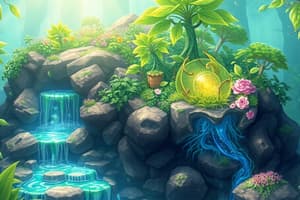Podcast
Questions and Answers
Where does photosynthesis occur?
Where does photosynthesis occur?
- Chloroplasts (correct)
- Mitochondria
- Endoplasmic reticulum
- Cytosol
In which process do producers obtain energy?
In which process do producers obtain energy?
- Photosynthesis (correct)
- Fermentation
- Cellular respiration
- Glycolysis
What is the main reason for energy loss in each step of a food chain?
What is the main reason for energy loss in each step of a food chain?
- Increased trophic levels
- Conversion to heat energy (correct)
- Enhanced photosynthetic efficiency
- Decreasing water availability
What is the impact of removing a predator from a food web?
What is the impact of removing a predator from a food web?
What are the components of cell theory?
What are the components of cell theory?
Why is competition observed between organisms of the same species and different species?
Why is competition observed between organisms of the same species and different species?
Flashcards are hidden until you start studying
Study Notes
Photosynthesis and Cellular Respiration
- Photosynthesis produces energy, while cellular respiration consumes energy.
- Photosynthesis occurs in chloroplasts, while cellular respiration occurs in mitochondria.
- Aerobic cellular respiration requires oxygen, whereas anaerobic cellular respiration does not.
Ecosystems and Energy
- Producers (plants) obtain energy through photosynthesis, while consumers (animals) obtain energy by consuming other organisms.
- Energy is lost in each step of a food chain due to heat, waste, and energy storage.
- Matter is lost from a food chain through waste, decomposition, and respiration.
Symbiosis and Interaction
- Mutualism, commensalism, and parasitism are the three main types of symbiosis.
- Biotic and abiotic factors interact in ecosystems, with biotic factors being living organisms and abiotic factors being non-living components.
Human Impact and Ecosystems
- Human activities can impact ecosystems, leading to changes in populations, communities, and ecosystems.
- Natural impacts on ecosystems include natural disasters, climate change, and habitat destruction.
- Healthy ecosystems provide benefits to humans, including clean air and water, soil formation, and climate regulation.
Cell Biology
- The cell theory consists of three main components: all living organisms are composed of cells, cells are the basic units of life, and all cells arise from pre-existing cells.
- Plant cells have a cell wall, chloroplasts, and a large central vacuole, while animal cells have lysosomes and a smaller vacuole.
- Organelles in cells have specific functions, such as the nucleus controlling cell growth and the mitochondria generating energy.
- Hormones are chemical messengers that help regulate various bodily functions, and glands in the endocrine system produce these hormones.
Studying That Suits You
Use AI to generate personalized quizzes and flashcards to suit your learning preferences.




